| Article ID | Journal | Published Year | Pages | File Type |
|---|---|---|---|---|
| 1604660 | International Journal of Refractory Metals and Hard Materials | 2007 | 8 Pages |
A series of cemented carbide materials were prepared using a coextrusion process, followed by rapid omnidirectional compaction for complete consolidation. The coextrusion process allows the carbide and metal binder phases to be reengineered into specific locations at a mesoscale level (10’s to 100’s of microns), resulting in a functionally designed cellular (FDC) architecture. Results of the study showed that the wear performance of FDC carbide materials was not dependent on the orientation of the composite architecture, despite the anisotropic nature of the material. It was determined that the wear characteristics of the FDC materials were controlled by the formation of Co2+xW4−xC, which led to increased material loss due to fracture causing as much as a 330% decrease in wear resistance of the FDC materials as compared to monolithic ROC materials with equivalent cobalt content.
